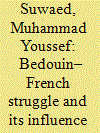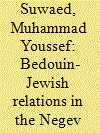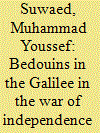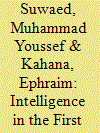|
|
|
Sort Order |
|
|
|
Items / Page
|
|
|
|
|
|
|
| Srl | Item |
| 1 |
ID:
154063


|
|
|
|
|
| Summary/Abstract |
The post-World War I partitioning of the Ottoman Empire, especially the League of Nations’ appointment of Britain and France as the mandatory powers for Palestine and Syria respectively, influenced the lives of the inhabitants of Upper Galilee. With the district left in December 1919 under French rule, the elated Christians began to avenge themselves on their long-time Bedouin opponents, who for their part supported the short-lived pan-Arab kingdom proclaimed in Damascus by Emir Faisal ibn Hussein of Mecca. With the Upper Galilee deteriorating into internecine strife, the Jews, perceived as supporters of the French, became a target for Bedouin attacks.
|
|
|
|
|
|
|
|
|
|
|
|
|
|
|
|
| 2 |
ID:
142756


|
|
|
|
|
| Summary/Abstract |
On the foundation of the first Jewish settlements in the Negev, at the start of the 1940s, the Bedouins welcomed the Jewish settlers. The local personal connections and mutual acquaintance between them created a feeling of closeness. The symbiosis of daily life and mutual help in the fields of personal needs, from medicine to transport, replaced their mutual fears.
However, two factors quickly changed this attitude. The first was a severe drought, which struck the Negev in the winter of 1947, and brought with it a difficult economic situation, followed by several robberies and disputes, and damage to property. The second factor was the incessant encouragement given by the leaders of the Palestinian National Movement to the Bedouins to join the struggle against the Jewish population, especially after the UN decision in November 1947, that is, after the partition of Palestine and the inclusion of the Negev within the borders of the Jewish state.
Most of the Bedouins joined the Palestinian National Struggle. Friends of yesterday became today's enemies. The years 1947–1949 were a period of anarchy, which continued well into the 1950s. In this period the State of Israel was established. Consequently, the Jewish population in the Negev was no longer the party responsible for the relationship with the Bedouins, as the Israeli government took its place. Also contact between neighbors was reduced after the Bedouins were evacuated toward the ‘fence’ region, in the Beer-Sheva Valley. The freedom the Bedouins enjoyed before the war did not exist anymore.
|
|
|
|
|
|
|
|
|
|
|
|
|
|
|
|
| 3 |
ID:
151857


|
|
|
|
|
| Summary/Abstract |
The relations of the Bedouins with the Jewish population during the War of Independence were very complex. The Bedouins were both opponents and friends. Bedouin groups helped the Jews in their struggle against the Palestinian national movement and against the Arab armies like Arab-al-Hib. Before the foundation of the state, these Bedouins had already participated in the protection of the security of the Jewish population. They supplied intelligence on events of the Arab and Palestinian sides, and also fought by the side of the Jews in the War of Independence, but at that time other groups joined the Palestinian national movement and took part in the struggle against the Jewish population, more so after the declaration of the partition plan in the United Nations. Subsequently, Bedouin fighting gangs were established and they joined the Palestinian struggle with the Jewish population.
|
|
|
|
|
|
|
|
|
|
|
|
|
|
|
|
| 4 |
ID:
158534


|
|
|
|
|
| Summary/Abstract |
Intelligence skills and security awareness were consistent with the rise and spread of Islam as a new religion.1 According to Muslim tradition, Muhammad habitually sought solitude on Mount Hiraa, near Mecca. One night in the year 610 AD, he had an epiphany: the angel Gabriel appeared in a dream and ordered him to read, but Muhammad refused. Some claim that he was afraid of the magnitude of the mission, while others claim that he was simply illiterate. But when the angel insisted, he read certain verses from the Qur’an. When he awoke he returned home, telling his wife Hadija about the epiphany. Hadija was to first to realize that it was a revelation, and that Muhammad was the emissary of the Lord. Becoming the first believer, Hadija thereafter supported Muhammad every step of the way. Without her it would have been extremely difficult for him to accept the burden of the revelation and the divine mission. See: The Holy Qur’an, Chapter 53—An-Najm (The Star), Verse 4; The Holy Qur’an, Chapter 96—Al-‘Alaq ((The Clot), Verses 1–5;
Emory C. Bogle, Islam: Origin and Belief (Austin: University of Texas Press, 1998), p. 6.
[Google Scholar][Google Scholar]
In its first three years of inception, Islam was an underground movement. The prophet Muhammad (570–632 AD) realized that, due to the hostility of the dominant majority in Mecca, he had to be cautious of his moves and intentions and those of his followers. What was becoming a new religion was revealed to only his most carefully selected and loyal associates. The Prophet knew that, in the preliminary stage, any information spillage could lead to harsh responses from the local civil and spiritual leaders, including measures to suppress this new religious movement. Thus, he adopted secrecy, regarding not only the identity of his selected recruits/believers but also the location of their meeting place—the house of Islam—a secret safe house where he met and preached to those he invited to join the new religion.
|
|
|
|
|
|
|
|
|
|
|
|
|
|
|
|
|
|
|
|
|